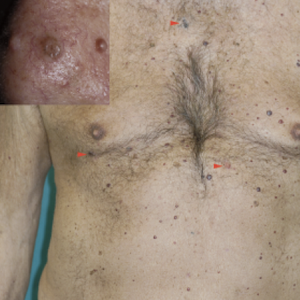Eruptive basal cell carcinoma and lenalidomide: rising awareness among dermatologists

HTML: 14
All claims expressed in this article are solely those of the authors and do not necessarily represent those of their affiliated organizations, or those of the publisher, the editors and the reviewers. Any product that may be evaluated in this article or claim that may be made by its manufacturer is not guaranteed or endorsed by the publisher.
Because of its higher level of safety compared to its parent medicine, thalidomide, lenalidomide (L) is chosen for the treatment of multiple myeloma. We report a patient who, within a month of using L, developed more than 10 basal cell carcinomas.
Arora M, Gowda S, Tuscano J. A comprehensive review of lenalidomide in B-cell non-Hodgkin lymphoma. Ther Adv Hematol 2016;7:209-21.
Sanchez-Palacios C, Guitart J. Hydroxyurea-associated squamous dysplasia. J Am Acad Dermatol 2004;51:293-300.
Nahmias Z, Nambudiri VE, Vleugels RA. Thalidomide and lenalidomide for the treatment of refractory dermatologic conditions. J Am Acad Dermatol 2016;75:210-2.
Dimopoulos MA, Richardson PG, Brandenburg N, et al. A review of second primary malignancy in patients with relapsed or refractory multiple myeloma treated with lenalidomide. Blood 2012;119:2764-7.
FactMed Medication Safety Directory. Available from: http://factmed.com/study-lenalidomide-causing-BASAL%20CELL%20CARCINOMA.php Accessed on: 19 February 2017.
Chen AC, Martin AJ, Choy B, et al. A phase 3 randomized trial of nicotinamide for skin-cancer chemoprevention. N Engl J Med 2015;373:1618-26.
Copyright (c) 2022 the Author(s)

This work is licensed under a Creative Commons Attribution-NonCommercial 4.0 International License.
PAGEPress has chosen to apply the Creative Commons Attribution NonCommercial 4.0 International License (CC BY-NC 4.0) to all manuscripts to be published.





 https://doi.org/10.4081/dr.2022.9534
https://doi.org/10.4081/dr.2022.9534



